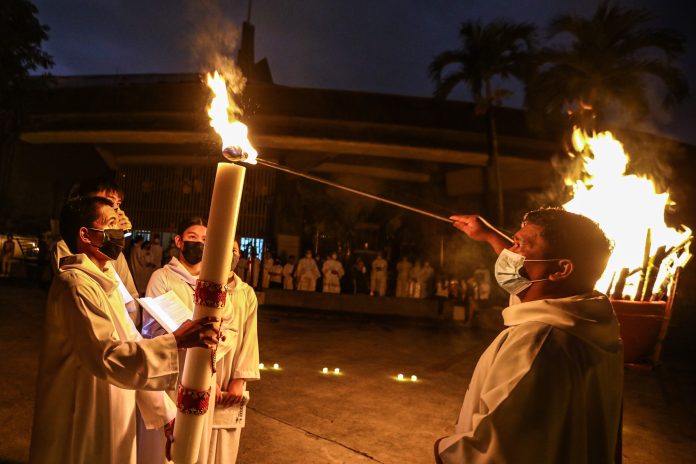Today, Palm Sunday, the whole church starts to commemorate what it calls the “Paschal Mystery”.
What does it actually mean? The Tagalog version taken from Spanish does not help to make it clearer, “Misteryo Paskwal.” It only makes it more complicated.
In simple language, it means the commemoration of “the suffering, death, and resurrection of Jesus”. The main thought in people’s minds is that Jesus died for our sins; we are saved because of his death and resurrection. These are canned answers which we merely repeat from the catechism. But what does this actually mean in concrete?
During one of those hot summer months years ago, a co-seminarian who lived in the city asked if he could accompany me to my rural hometown for a few weeks of vacation. It was also the time when the sineguelas (Spanish plum) trees had shed their leaves before the small fruits appeared on their fragile branches. The city boy commented to the farmer whose field we visited: “Oh, it must really be hot here. Everything is dry. Even the sineguelas are dying.”
The farmer was so polite; he did not reply. But when my seminarian classmate had walked a bit farther, the farmer whispered to me: “I pity these city boys. They do not know that the sineguelas have to shed all their leaves before they bear fruit. Boys like him need to stay here a bit longer to understand.”
What the farmer said is but a parallel metaphor of what the gospel has long proclaimed: “Unless a grain of wheat falls to the earth and dies, it remains only a simple grain but if it dies, it yields a rich harvest” (John 12:24). And only those who have been in the farm for quite some time know that this is the natural rhythm of life itself – of sineguelas leaves, of wheat grains and of human lives.
There is a difficult word that preachers, catechists, and theologians talk about but do not explain quite successfully: “paschal mystery”. One old lady asked me: “Father, ano nga yong buong pangalan noong Pascal na sinabi mo kanina? Parang may apeldiyo pa yon. Ano nga ang apelyido noon?” I answered: “Mystery”. “Ah yon nga,” she replied.
But it was the simple farmer who explained it to me quite clearly that day.
Living the Paschal Mystery starts with one’s encounter with Jesus. In the event of his resurrection, the disciples began reflecting on the significance of his passion, death, and resurrection.
Why did he have to suffer and die in the first place? How were they to make sense of his otherwise senseless death? How shall they understand the news that some women and men disciples talked and ate with him after his death? What meaning and consequences do all these events have for their lives, they asked.
The same questions continue to be asked until today. In the following days, I would like to outline some major frameworks with which Christian theology has tried to answer the same question throughout the centuries.
With this, we hope to give meaning to the events we commemorate in the following days.
Father Daniel Franklin Pilario, C.M., is the President of Adamson University in Manila. He is a theologian, professor, and pastor of an urban poor community on the outskirts of the Philippine capital. He is also Vincentian Chair for Social Justice at St. John’s University in New York.









